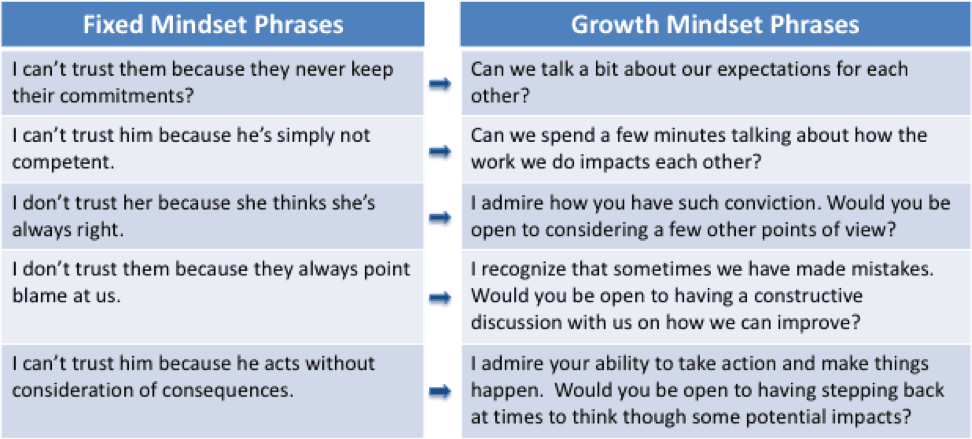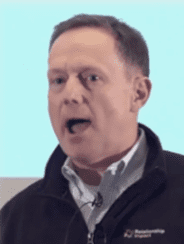The next step is for the team to identify and gain agreement on the symptoms of toxicity that are impacting them. CEOs should convey that any structural changes such as termination or redefining roles will be insufficient until the team understands the roots of the relational damage. To get to the root of the dysfunction, the CEO should present his/her view of the root issues – ‘we have had two sets of rules’; ‘I have stifled dialogue’; ‘we haven’t had clarity on roles’ – and ask each team member to provide further input. After gaining a collective understanding of the challenge, the team should spend some time to reset expectations for how they want their team to operate – ‘assuming that the team is working great six to twelve months from now what will it look and feel like?’ Once the challenge is clear and the expectations are clear they can begin to do the hard work as a team and individuals to begin to build a healthier and more productive environment.
Step Three – Rebuild Trust
An earlier article we wrote for Chief Executive called Trust is What Fuels Great Leadership Teams suggests that trust consists of three main components – trust in another’s competence, character and dependability. Each takes a big hit on toxic leadership teams and trust is an extremely difficult thing to rebuild. To start the rebuilding process, team members have to acknowledge any contribution they have made to an unhealthy atmosphere; even if as simple as not speaking up about concerns or talking negatively about teammates. Demonstrating this type of vulnerability begins to loosen the tension – ‘I recognize that renegotiating team commitments with the CEO makes you feel like I am going behind your back.’
Next, individuals have to evaluate the assumptions they have made about their teammates and take steps to test whether the assumptions are true or not. One type of assumption is what we refer to as the ‘hangover’ effect – despite the induction of a new CEO with a hands-off, empowering approach some team members still behaved as if he was micromanaging – ‘why is he asking that,’ ‘how come he’s provides so much detail in his email responses.’ Other assumptions are based on the behaviors team members see from their colleagues related to competence, character or dependability. ‘she has no idea what she is doing because she asks too many questions and takes too long to get to the point.’ This certainly may be a development challenge, but it is not necessarily a question of competence. Trust can begin to be repaired when teammates start to discuss the behaviors they are seeing that contribute to assumptions and begin to dig deeper to understand the motivations and intent behind the behaviors – ‘now I recognize that you are detail oriented and always seeking to get to the best course of action.’
After leadership teams take time to demonstrate vulnerability and test their assumptions, it is critical that they make collective and individual commitments to strengthen how the team operates. When teams are recovering from a toxic environment a good practice is to establish a set of behavioral operating principles that serve as a foundation for holding each other accountable. Operating principles might range from ‘we will actively support the decisions made by the team’ to ‘we will not speak negatively about our teammates behind their backs’ to ‘we will talk directly to our colleagues about any challenges.’ Based on their self-reflection and the feedback they are receiving from teammates; each individual should make specific behavioral commitments designed to help strengthen how the leadership team operates. An example commitment might include: ‘I commit to adhere to team decisions and will not try to renegotiate for my benefit outside of the team construct and when I don’t live up to this commitment please give me feedback.
Embracing what Carol Dweck refers to as a growth mindset can help with this commitment making approach and help us unlock our ingrained assumptions. A growth mindset is a belief that learning and intelligence can grow with time and experience which is quite different from what Dweck refers to as a fixed mindset or belief that an individual’s qualities are fixed and therefore cannot change. Below is a graphic that illustrates the shift in behaviors and mindset that can help leadership teams begin to repair trust.
 Recovering from toxic leadership team environments is not easy and requires nurturing and commitment on the part of every team member. Strong leadership from the CEO will set the tone for recovery and enable team members to self-evaluate and make commitments necessary to address the toxicity and begin to build a healthy and productive environment.
Recovering from toxic leadership team environments is not easy and requires nurturing and commitment on the part of every team member. Strong leadership from the CEO will set the tone for recovery and enable team members to self-evaluate and make commitments necessary to address the toxicity and begin to build a healthy and productive environment.
Read more: How To Measure Leadership Team Effectiveness

Chief Executive Group exists to improve the performance of U.S. CEOs, senior executives and public-company directors, helping you grow your companies, build your communities and strengthen society. Learn more at chiefexecutivegroup.com.
0

1:00 - 5:00 pm
Over 70% of Executives Surveyed Agree: Many Strategic Planning Efforts Lack Systematic Approach Tips for Enhancing Your Strategic Planning Process
Executives expressed frustration with their current strategic planning process. Issues include:
Steve Rutan and Denise Harrison have put together an afternoon workshop that will provide the tools you need to address these concerns. They have worked with hundreds of executives to develop a systematic approach that will enable your team to make better decisions during strategic planning. Steve and Denise will walk you through exercises for prioritizing your lists and steps that will reset and reinvigorate your process. This will be a hands-on workshop that will enable you to think about your business as you use the tools that are being presented. If you are ready for a Strategic Planning tune-up, select this workshop in your registration form. The additional fee of $695 will be added to your total.

2:00 - 5:00 pm
Female leaders face the same issues all leaders do, but they often face additional challenges too. In this peer session, we will facilitate a discussion of best practices and how to overcome common barriers to help women leaders be more effective within and outside their organizations.
Limited space available.

10:30 - 5:00 pm
General’s Retreat at Hermitage Golf Course
Sponsored by UBS
General’s Retreat, built in 1986 with architect Gary Roger Baird, has been voted the “Best Golf Course in Nashville” and is a “must play” when visiting the Nashville, Tennessee area. With the beautiful setting along the Cumberland River, golfers of all capabilities will thoroughly enjoy the golf, scenery and hospitality.
The golf outing fee includes transportation to and from the hotel, greens/cart fees, use of practice facilities, and boxed lunch. The bus will leave the hotel at 10:30 am for a noon shotgun start and return to the hotel after the cocktail reception following the completion of the round.